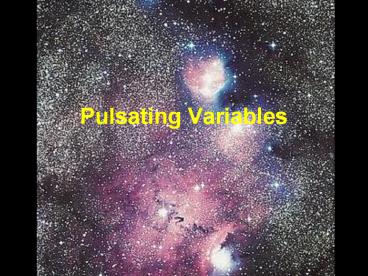Pulsating Variables PowerPoint PPT Presentation
Title: Pulsating Variables
1
Pulsating Variables
0
2
Cepheid Variables
0
Discovered by J. Goodricke (1784)
Prototype d Cephei
Light curve of d Cephei
3
Cepheid VariablesThe Period-Luminosity Relation
0
The variability period P of a Cepheid variable is
positively correlated with its luminosity
MV -2.80 log10Pd 1.43
4
Cepheid Variablesas Distance Indicators
0
- Measuring a Cepheids period
- determine its absolute magnitude
- Distance indicator!
Cepheids are Ib supergiants, L 103 - 4 L0
gt Identifiable out to several Mpc!
5
The Instability Strip
0
Classical Cepheids
W Virginis Stars metal-deficient (Pop. II),
Cepheid-like
Increasing Period
RR Lyrae Stars Pop. II horizontal-branch
nearly standard-candle luminosity!
d Scuti Stars Evolved F stars near MS
6
Stellar Pulsations
Estimate from sound travel time through the star
P r-1/2
Cepheids all have approx. the same surface
temperature. gt Higher L gt Larger R gt Smaller
r gt Larger P
7
Radial Pulsations
0
8
The Valve Mechanism
0
Nodal zone is opaque and absorbs more radiative
flux than necessary to balance the weight from
higher layers. gt Expansion
Upon expansion, nodal zone becomes more
transparent, absorbs less radiative flux gt
weight from higher layers pushes it back inward.
gt Contraction.
Upon compession, nodal zone becomes more opaque
again, absorbs more radiative flux than needed
for equilibrium gt Expansion
9
For the valve mechanism to work k needs to
increase with increasing r and T
0
Kramers Opacity Law
aR r T-7/2
log(aR cm-1)
Gas fully ionized opacity dominated by free-free
absorption
Gas gradually becoming ionized
104
105
106
107
Temperature K
? Partial Ionization Zones!
10
Location of Partial Ionization Zones
0
LPVs Valve mechanism driven by H partial
ionization zones
104 K
4x104 K
Instability strip Walve mechanism driven by He
partial ionization zones
11
Non-Radial Modes of Variability
g-modes
fnet (dF/dV)net g (rs rb)
bubble (b)
surrounding medium (s)
PowerShow.com is a leading presentation sharing website. It has millions of presentations already uploaded and available with 1,000s more being uploaded by its users every day. Whatever your area of interest, here you’ll be able to find and view presentations you’ll love and possibly download. And, best of all, it is completely free and easy to use.
You might even have a presentation you’d like to share with others. If so, just upload it to PowerShow.com. We’ll convert it to an HTML5 slideshow that includes all the media types you’ve already added: audio, video, music, pictures, animations and transition effects. Then you can share it with your target audience as well as PowerShow.com’s millions of monthly visitors. And, again, it’s all free.
About the Developers
PowerShow.com is brought to you by CrystalGraphics, the award-winning developer and market-leading publisher of rich-media enhancement products for presentations. Our product offerings include millions of PowerPoint templates, diagrams, animated 3D characters and more.

